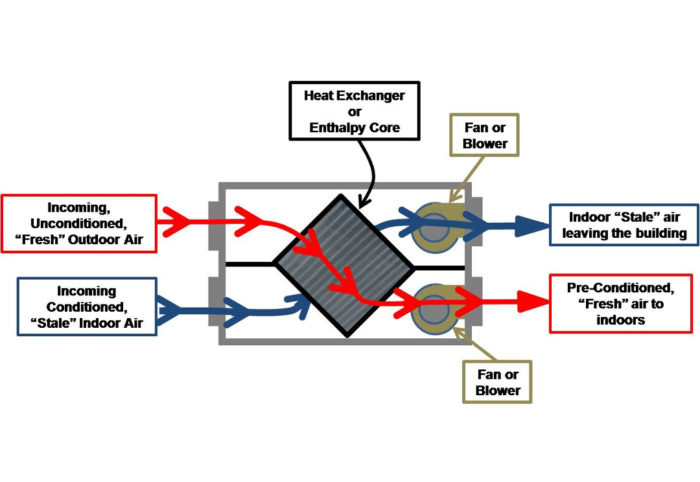A Step-by-Step Guide to HRV Maintenance
How Heat Recovery Ventilation Improves Indoor Air High Quality and Reduces Energy Costs
Heat Recovery Ventilation (HRV) systems play an important role in boosting interior air high quality while all at once decreasing energy costs. By successfully trading stale interior air with fresh outdoor air, HRVs assist keep ideal moisture and lower contaminants. In addition, their capacity to recuperate warm from outward bound air lessens the pressure on heating and cooling systems. As power prices remain to increase, understanding the complete possibility of HRV systems ends up being progressively important for house owners and organizations alike.
Understanding Heat Recovery Ventilation Equipments

Heat recovery ventilation (HRV) systems play a necessary function in improving indoor air top quality, particularly in modern-day, energy-efficient buildings. These systems are created to move warmth from the outward bound stagnant air to the incoming fresh air, thus decreasing energy loss while maintaining suitable temperature level degrees indoors. HRVs consist of a heat exchanger, fans, and ductwork, helping with the continual circulation of air. By eliminating interior pollutants and presenting fresh air, HRVs assist to stabilize moisture degrees, protect against mold growth, and reduce irritants. The performance of HRV systems hinges on their capability to recover approximately 80% of the warmth from the worn down air, advertising energy conservation while guaranteeing a healthy indoor setting. Their assimilation is essential in achieving lasting living techniques.
The Importance of Indoor Air Quality
Indoor air quality (IAQ) is an essential variable affecting the wellness and wellness of residents in any type of environment. Poor IAQ can lead to numerous health and wellness problems, consisting of breathing issues, allergic reactions, and tiredness. In addition, it can worsen present problems such as asthma. Aspects adding to low IAQ consist of contaminants from indoor sources like cleaning up representatives, mold and mildew, and poor air flow. Keeping excellent IAQ is essential for promoting a safe and comfy living or working area. Reliable approaches to enhance IAQ entail regular surveillance of air quality, appropriate ventilation systems, and minimizing making use of damaging materials indoors. By prioritizing IAQ, individuals can ensure a much healthier environment that cultivates performance and general high her latest blog quality of life.
Energy Performance Perks of HRV Solutions
Several house owners and structure supervisors are progressively identifying the energy performance benefits of warmth recuperation ventilation (HRV) systems. By transferring warm from worn down interior air to incoming fresh air, HRV systems substantially decrease the energy required for heating and cooling. This procedure reduces dependence on conventional cooling and heating systems, bring about reduced power costs. Furthermore, HRVs aid maintain a well balanced indoor environment, preventing too much heating or cooling demands. The capacity to recoup approximately 90% of the heat from outbound air additionally sustains sustainability efforts by lowering overall power consumption. HRV systems contribute not just to cost financial savings however additionally to a lowered carbon footprint, lining up with the growing emphasis on energy-efficient structure methods.
Installation and Upkeep Considerations
The reliable application of heat healing air flow (HRV) systems needs mindful consideration of setup and maintenance factors to guarantee peak performance. Appropriate positioning of the HRV device is crucial, as it must be installed in a place that makes the most of airflow while reducing sound disturbance. In addition, ductwork must explanation be appropriately sized and insulated to avoid power loss. Regular upkeep, consisting of filter substitute and system cleaning, is essential to protect optimum functionality and interior air top quality. Proprietors should establish a routine maintenance timetable to recognize and deal with possible issues prior to they intensify. Cooperation with knowledgeable professionals during both installment and maintenance phases can improve the long life and effectiveness of HRV systems, ultimately resulting in far better interior environments and lowered energy costs.
Real-World Applications and Success Stories
Discovering real-world applications of heat recuperation ventilation (HRV) systems reveals their substantial impact on indoor air high quality and energy efficiency across various setups. In property structures, homeowners have reported enhanced air quality, leading to fewer allergies and respiratory system problems. Schools carrying out HRV systems have noted improved pupil concentration and minimized absenteeism as a result of much better ventilation. Industrial structures, such as offices and retail areas, have actually experienced lower energy expenses and increased staff member performance. A business workplace in a temperate environment accomplished a 30% reduction in power costs after setting up an HRV system. These success tales demonstrate that HRV technology not only adds to healthier settings yet additionally provides substantial economic benefits, making it a beneficial financial investment for numerous industries.
Often Asked Questions
Can HRV Solutions Lower Irritants in Indoor Air?
The performance of HRV systems in minimizing interior irritants largely depends upon their navigate to these guys capability to filter and exchange air. HRV Heat Recovery Ventilation. By constantly changing stale air, these systems can considerably reduce allergen degrees throughout interior atmospheres

Just How Does Humidity Affect HRV System Performance?
Humidity greatly affects HRV system efficiency; high levels can result in condensation, minimizing efficiency, while reduced moisture may boost air exchange. Balancing humidity is important for suitable operation and preserving interior air top quality.
Are HRV Systems Noisy During Operation?
HRV systems can generate varying noise levels throughout operation, depending on their design and setup. Some units operate silently, while others might generate visible audio, specifically at greater air flow settings or when inadequately maintained.
What Is the Typical Lifespan of an HRV System?

Can HRV Systems Be Utilized in All Environments?
HRV systems can be utilized in different environments, yet their efficiency may differ - HRV Heat Recovery Ventilation. In severe temperatures, modifications or supplementary systems may be needed to guarantee ideal efficiency and comfort while maintaining indoor air quality